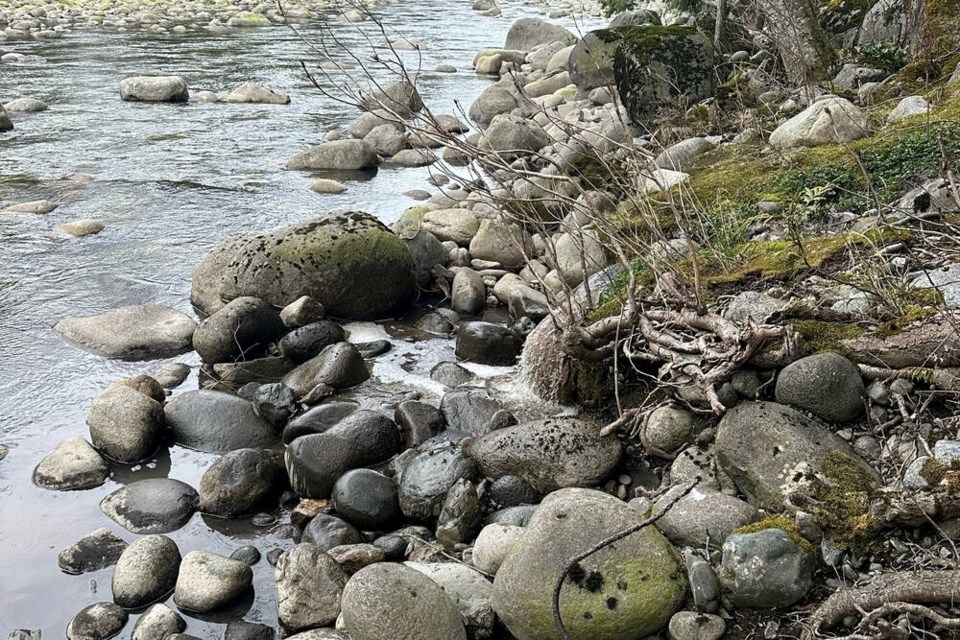An investigation is underway into a raw sewage leak that’s spilling into Capilano River.
Meanwhile, advocates from North Shore Streamkeepers are warning that the spill could lead to a significant kill of fish in the area, as salmon fry emerging to take their first gulp of air will be exposed to contaminants. The problem is compounded by unusually low flows in the river for this time of year.
On Monday, the District of North Â鶹´«Ã½Ó³»reported that sewage was leaving private property and entering the Capilano River at a storm outfall pipe. The Ministry of Environment said the amount of material released into the waterway is unknown.
Environmental response officers were on site Friday along with representatives from the district, Coastal Health Authority and Sḵwx̱wú7mesh Úxwumixw (Squamish Nation), as most of the affected area falls within the Capilano 5 Reserve.
On Twitter, Squamish Nation advised the public to “stay clear of the water in the area and to avoid using it for fishing, swimming, bathing or entering the water for any reason.”
While Ministry of Environment spokesperson David Karn said the exact location of the leak’s source had not been determined, from the ministry lists 2020 Fullerton Ave., the address of the Hollyburn Building at Woodcroft Estates apartments.
“A plumbing and environmental consultant were on site, but could not confirm the source of the released sewage in the storm drain network,” reads a statement from the ministry. Environmental response officers “collected water samples from around the outfall pipe and from the Squamish First Nation reserve.”
Those samples from around the outfall pipe were delivered to a local analytical lab, the ministry said, while the samples from the Squamish Nation reserve will be delivered to the lab on Monday.
The ministry’s file notes that the responsible person or spiller is legally required to clean up or manage the cleanup of a spill. “In incidents where the responsible person is unknown, unable or unwilling to manage the cleanup, the Ministry of Environment and Climate Change Strategy may assume the role.”
Wynford Group, which manages the Hollyburn Building apartments, could not be reached for comment on Saturday.
Unusually low river flows could magnify environmental harm
The immediate concern is the emergence of newly hatched chum salmon fry, which is happening across the North Shore right now, says North Shore Streamkeepers president Keegan Casidy.
“Essentially, the first thing they do once they emerge from the gravel, they swim right to the surface to take a gulp of air and fill their air bladder,” he said. “I’m not sure what kind of contaminant this is or how that interacts with the main watercourse, but fish moving up and down the water column here are going to be exposed to whatever the pollutants are.”
“Chances are there’s going to be totally negative impacts,” Casidy continued. “We could see some fish kills here for sure.”
There are also coho in the gravel, he said, and Brothers Creek is a major tributary just downstream of the spill site on the same, west side of the river. “As those fry are emerging and coming out of Brothers Creek, they’re also going to be exposed to these contaminants. So we could see a significant fish kill here in the short term.”
Casidy said he’s not sure if cleanup efforts could reduce the damage to the hatching salmon, or if the damage is already done. The area of the spill is especially unfortunate because it’s where salmon naturally spawn on the otherwise high-velocity river.
“It’s just really unfortunate timing too ... we’ve got super low flows,” he said. According to , the Capilano’s river level is around 0.75 metres and its flow is around two cubic metres per second.
“I’ve never seen it that low. I think that’s what we’d consider an August low-flow event for the Capilano,” Casidy said. “Any sort of contamination that’s going into the river right now, impacts are drastically magnified because there’s no flow to dilute that contaminant.”
Casidy said the Streamkeepers are in full support of whatever the Squamish Nation is looking at in terms of remediation. He said his organization’s suggestion would be to tap into the environmental damages fund or whatever fine results from this spill, and to enhance the affected area or downstream of the Fullerton bridge. Because it’s a very shallow gradient, water moves slowly through that entire section of the stream.
“I think it’s an area that we can do significant in-stream work to better restore and enhance that area and future resilience of the natural and wild salmon on the Capilano River system,” he said.



